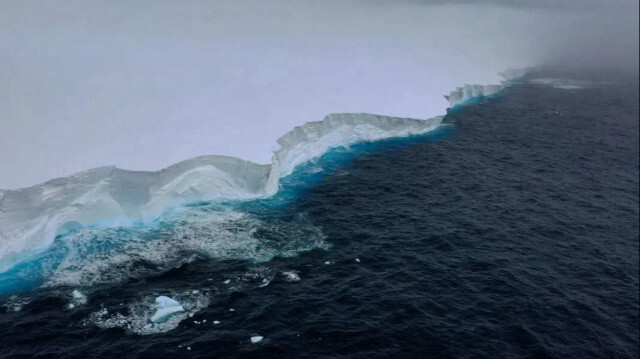
Experts differ over whether the melting of the world's largest iceberg, A23a, will accelerate since it started spinning after being caught in a vortex in Antarctica.
A23a broke away from the Filchner-Ronne Ice Shelf in Antarctica nearly four decades ago, in August 1986.
The iceberg remained stationary for around 34 years after the breakaway, but began moving with the ocean currents in 2020 and started headed towards the western part of the Weddell Sea, which is adjacent to Antarctica.
But the massive iceberg was caught in a vortex during the journey and since the beginning of this year has been circling the vortex.
While some experts think that this will prevent the iceberg from heading towards warmer waters and slow down its melting, others say the spinning will accelerate it.
Kate Hendry, deputy science leader of the Polar Oceans team at the British Antarctic Survey (BAS), and Alexander Brearley, a physical oceanographer at the BAS, told Anadolu that A23a's breakaway from the Filchner-Ronne Ice Shelf occurred in a natural process independent of the current climate crisis.
Scientists said A23a remained in cold waters until earlier this year, losing a very small part of its area in the process and shrinking from 3,850 square kilometers (1,486 square miles) to 3,672 square kilometers (1,418 square miles).
"A23a is currently spinning at around 15 degrees per day in an anticlockwise direction to the north of the South Orkney Islands, where it has been since spring 2024. The reason for this spin is that the iceberg is trapped in a small-scale ocean circulation known as a Taylor column that sometimes occurs when ocean currents flow over underwater mountains,” they said.
"A23a currently sits over one such mountain known as Pirie Bank, which is around 100 kilometers (62 miles) across horizontally and the top of which is at around a 1,000-meter (0.62-mile) depth.”
On the change in the rate of melting due to the circulation in which the iceberg is trapped, the researchers said: "We do not think the spinning process in itself inhibits iceberg melting, but it does prevent the iceberg moving northeastwards into warmer waters.”
"Typically, large icebergs would move northeast from this location into the warmer waters of the Antarctic Circumpolar Current and move rapidly towards the island of South Georgia. This pathway is known as 'iceberg alley.' Until the iceberg escapes from the Taylor column, melt is likely to be relatively slow."
- Risk of harm to life on sea floor
While the scientists are unsure how long the iceberg will remain in that location, they said another iceberg with similar characteristics was trapped in the same circulation for four years.
"The iceberg is an obvious hazard to marine shipping, though we are fortunate that it is well-surveyed by satellite imagery, meaning modern fishing, research and cruise vessels will be able to plot safe routes to avoid the iceberg," they said.
Huge icebergs can stir the sea floor, releasing more nutrients and carbon for creatures in the region, but they can also harm life on the sea floor, the researchers said.
- 'Spinning, fast motion are conducive to faster melt'
Eric Rignot, an Earth scientist at the University of California, said the iceberg will melt faster in the process of spinning in the vortex.
"Spinning and fast motion are conducive to faster melt because of more heat exchange with the ocean. The iceberg is therefore likely to start decaying faster. It will likely break up in smaller pieces," he said.
Saying the melting of the iceberg is not related to climate change, he added: “It is melting because it is a warmer, saltier environment to begin with. All icebergs drifting to sea are doomed to melt."
Rignot said the spinning motion of A23a is due to the circulation scheme of the ocean, noting that as the iceberg has a huge amount of inertia, it can continue to spin this way for years.
- 'It will hold its position for a long time'
Burcu Ozsoy, who chairs the TUBITAK Marmara Research Center's Arctic Research Institute based in Gebze, Türkiye, said the fact that A23a was caught in the vortex means that the iceberg will move in the direction of the strength and direction of the vortex for a while longer.
“Considering the depth of A23a below the sea surface in this order, this means that it will maintain its current position for a long time without melting or moving to warmer regions," she added.













